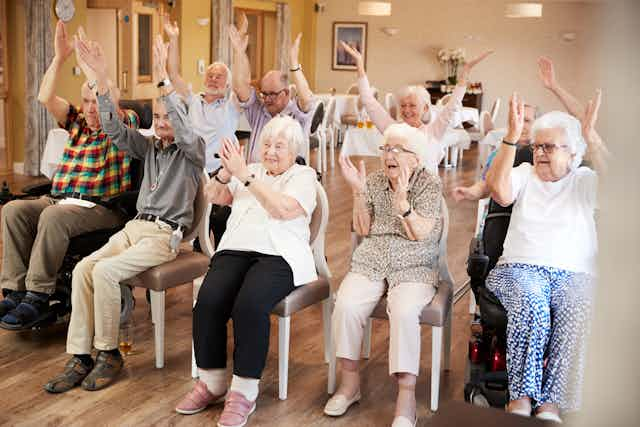Care homes are rarely a source of good news. The system is underfunded, understaffed and overextended, and homes are routinely found to be inadequate. Of the 2,934 homes the Care Quality Commission inspected in the year to December 2022, 1,224 were deemed inadequate or requiring improvement.
Low expectations and negative stereotypes, particularly in the media, exacerbate the problem. But when positive relationships are placed at the centre of adult social care, care homes have the potential to be joyful, lively places.
Our research has looked at what happens when care homes facilitate community connections between their older residents and refugees. We have found that singing, in particular, is a good tool for breaking down social barriers, reducing isolation and improving wellbeing. Group singing can benefit everyone.
How singing improves wellbeing
From 2016 to 2019, we worked with four care homes in Bolton, Greater Manchester, and a local choir which visited the homes once a month. The residents were older adults, predominantly white British. Some had diagnoses of dementia or mental health problems.
The choir was comprised of six to ten young people and adults from the Ephrata Church Community, a local black African church. They brought keyboards and guitars and set up shop in communal areas. The residents were free to come and go as they pleased.
The choir leader would introduce the songs and distribute lyrics, encouraging both residents and staff to join in. Afterwards they were asked about their experience of the session and whether they had any song requests for subsequent visits.
From the start, residents found the experience to be beneficial. One explained how little there was, usually, for them to do in the care home: “The staff are in rush, and we can’t have a proper conversation.” Research has long shown that this is not uncommon.
Joining in the singing project, by contrast, as one member of staff put it, “greatly improved [the residents’] moods and got them up dancing”. Another said how much it “brightens up the lives of people waiting for treatment”.
They especially like the fact that the choristers also learned a thing or two from Googling song requests they weren’t familiar with. One resident said that the song What a Friend We Have in Jesus is their “best song, the song they will sing during my funeral”.

How singing fosters connectedness
Singing has been shown to boost confidence, broaden communication skills and foster connections with others. The physiological benefits it brings are clear too: as a workout, it can strengthen the immune system, improve posture and aid sleep. It is also a natural antidepressant, lowering stress levels and improving mental alertness.
Research shows that group singing, specifically, increases levels of oxytocin, which fosters a greater sense of connectedness and contentment.
Context, however, mediates the impact of oxytocin. Hence, before the singing, each chorister introduced themselves, the school they go to (for children), the work they do, their hobbies and preferred food. This started a conversation with the residents, about having gone to the same school or liking the same food.
Group bonding can happen quickly across large groups when people have a shared motivation or focus; when their activities are aligned in what psychologists call behavioural synchronicity; and when they experience a collective sense of achievement. Rather than inviting residents to watch a performance, the fact that these sessions involved the choristers using songs chosen by the residents and actively encouraging them to clap and sing along encouraged connection.
The benefits of a greater sense of connection are clear. Loneliness is an enduring problem for older adults, especially in care homes. Despite living in shared accommodation, over 60% of older adults in care homes are moderately or severely lonely. Some studies show only 10% of care home residents’ time involves social interaction.
On a societal level, fostering connections can contribute to reducing social stigma, prejudice and isolation – issues faced by older adults and refugees alike. Spending time together (what psychologists term the “mere exposure effect”) can be enough to generate familiarity.
In addition, introductions at the start of singing emphasised the idea that everyone is unique – it reduced the perceived homogeneity of “older people” or “refugees”. Research suggests that environmental cues of social connectedness (sharing an activity, say, like singing together) also reduce bias. On a more basic level, the signing group challenges stereotypes of refugees as hostile and taking resources, to being ordinary and active members of their communities who make a positive contribution.
Further, better relationships between caregivers and care home residents can reduce staff burnout because they make the work more meaningful and rewarding. It acts as a buffer against stress, and some of the more difficult aspects of caregiving, such as working with aggression in people with dementia. This is known as “enrichment”, where caregiving gives meaning and pleasure to both parties, by giving something back to a previous generation, enjoying each other’s company, or learning something new.

Social care experts speak about “older-adult-centred care” wherein people are as autonomous as possible. This involves treating them with dignity, providing personalised support for their unique needs, and creating a social environment in which people feel meaningfully included.
Our research suggests there is an important fifth component – reciprocity – which is all about finding ways for older people to actively contribute to wider community life. When, conversely, they receive care passively, it can create an objectified, distanced relationship that reduces the sense of reward for everyone involved.
Our group singing project delivered on all fronts. Participants were treated with respect and involved in decision making. They forged connections with the choristers and each other, shared personal experiences and knowledge.
Greater community cohesion was achieved too, with connections forged between two groups so often isolated. As one younger member of the African choir said:
I really enjoy singing today, it helps me to be connected.

